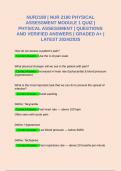Essay
C: UNDERSTAND HEALTH AND SAFETY, ASSOCIATED RISKS, SIDE EFFECTS AND LIMITATIONS OF IONISING AND NON-IONISING INSTRUMENTATION TECHNIQUES IN MEDICAL APPLICATIONS
- Institution
- PEARSON (PEARSON)
Radiation is used every day in the UK, it is used for different purposes such as medical, industrial, research and communication. Some of these can potentially be harmful when exposed, which must be controlled effectively. The health and safety Executive (HSE) regulates the work which exposes radia...
[Show more]












